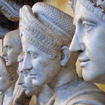did you know....?
pre intermediate level
Description
Materials
Main Aims
-
To provide gist, detailed and scan reading practice in the context of inventions
Subsidiary Aims
-
To provide practice for passive form
-
To provide speaking practice in the context of inventions
Procedure (35-44 minutes)
1. focus students on the board, there is a picture of Edison and Newton, i will ask them " Do you know who these people are?" "what did Newton discover?" " what did Edison invent?" 2. focus students on the board: there pictures of a turkish flag, kunefe and urfa kebap, and ask them " do you know who designed the turkish flag? who invented kunefe? who invented urfa kebap?" 3. group work, talk about the above questions 4. feedback; students will tell class what they think 5. feedback; error correction
1. focus students on the board 2 elicit base, design, discover, invent/ model and drill chorally and individually THEN write it on the board 3. do M P F for each of them 4. don't forget stress and part of speech 5. do CCQs for each of them 6. in pair, have students do part "a" of the reading and vocabulary section. 7. feedback; students tell class their answers 8. feedback; error correction
1. focus students on the board, where there are pictures of a Nike logo, tinned food, golf, botox and House M.D.'s main character; Gregory House 2. " these are all pictures from the text you are about to read, what do you think the text will be about?" 3. group work; have students discuss the above question 4. feedback; students will tell class what they think 5. feedback; error correction
1. "read the text very fast, individually 2. in pairs tell me if your predictions were correct 3. feedback; error correction.
1. " could you help me write the passive formula on the board?", write the passive formula 2. in pairs " read the text one more time and fill the blank spaces with the passive form of these verbs." in page 77 of the SB 3. feedback; students tell class what their answers are 4. feedback; error correction
1. in pairs students will read the text one more time and discuss with each other which information could be wrong: " read the text with your partner. one of the informations here is wrong. can you find out which one? and what should it be?" 2. do an example: " for example i don't think the Nike logo was designed by a woman, i think it was designed by a man." 3. feedback; students will tell class what they think. 4. feedback; error correction
1. these are all word from the text 2. in pair try to match the word to it's meaning 3. do one example 4. do ICQs 5. feedback; students will tell class what their answers are 6. feedback; error correction
1. put students into 2 groups 2. write these words in random order on the board :the Internet (most recent), light bulb, telephone, refrigerator, braille, thermometer, microscope, printing, paper, wheel elicit any necessary words, elicit B.C. 3. ask students to work together and write the year they think each one was invented. 4. have them write their answers on the board 5. compare and give them points: The Internet 1969, light bulb 1906, telephone 1876, refrigerator 1850,braille 1829, thermometer 1593, microscope 1590, printing 1440, paper 100, wheel around 3,500 BC * this activity is adapted from British Council website. https://www.teachingenglish.org.uk/article/inventions

